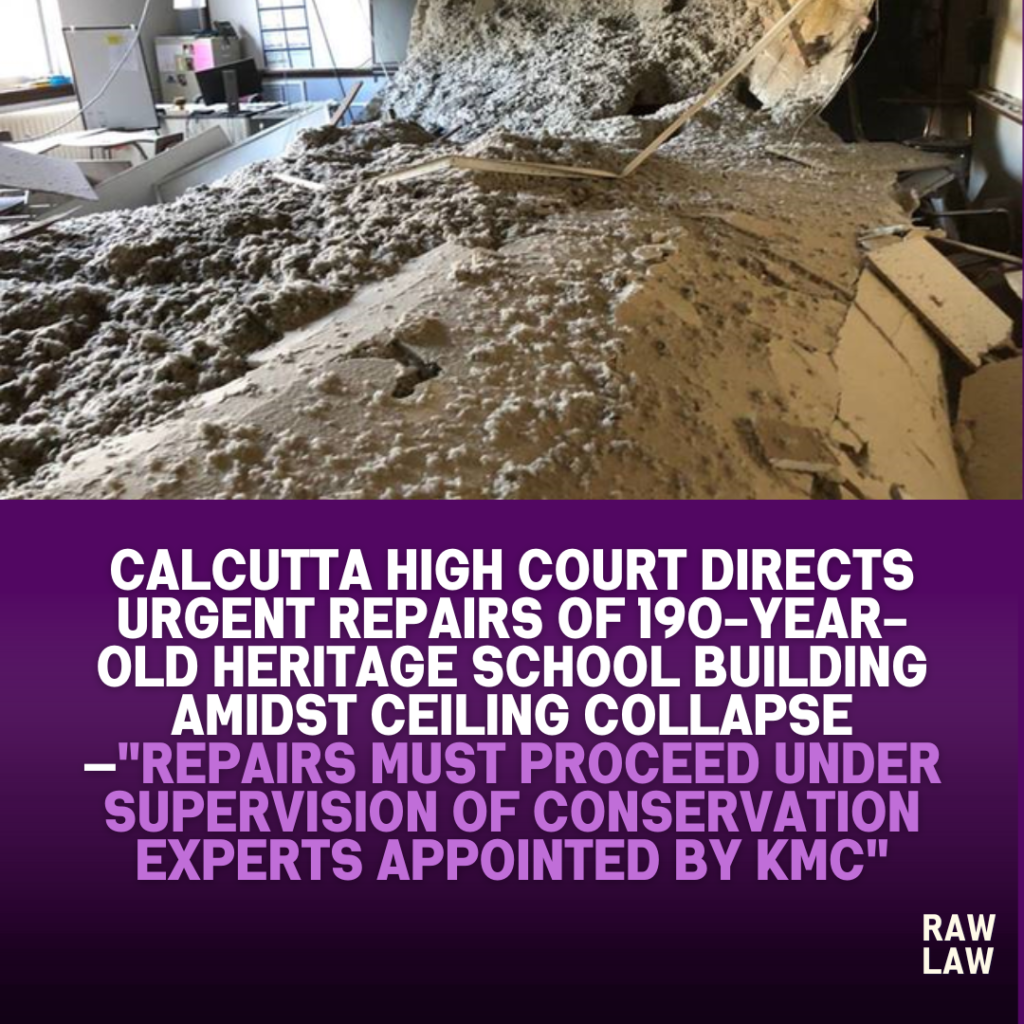Court’s Decision
In APOT/157/2025 with WPO/379/2025, the Calcutta High Court admitted an appeal by a 190-year-old heritage school and, taking note of a ceiling collapse and the dangerous condition of the building, directed immediate repair works to be undertaken. The Court ordered that all damaged areas identified in the Kolkata Municipal Corporation (KMC)’s latest inspection report dated 9 June 2025 be repaired under the supervision of a Conservation Architect and Structural Engineer nominated by the KMC Commissioner. The cost of such repairs is to be borne by the school, and progress reports must be submitted to the Single Bench every 45 days.
Facts
The appellants, including a historic school building classified as a Grade-I heritage structure, approached the Division Bench in appeal against an interim order dated 22 May 2025 of the Single Bench that called for affidavits but did not grant immediate relief. The appellants had filed a writ petition complaining that KMC was obstructing their attempts to undertake urgent repairs and renovations, even after a recent incident where part of a concrete ceiling collapsed.
The school is approximately 190 years old and was officially declared a heritage structure in 2009, although it enjoyed that status prior to its formal classification. KMC, however, contended that the school allowed the building to deteriorate without making timely applications for repairs and had carried out certain works unauthorisedly and without permission from either the KMC or the West Bengal Heritage Commission.
Issues
- Whether the school authorities are entitled to carry out urgent repairs on a Grade-I heritage building without prior permission from heritage authorities.
- Whether the collapse of a ceiling portion necessitates immediate judicial intervention to ensure safety.
- Who should bear responsibility for deterioration, and how should heritage repair work be supervised?
Petitioner’s Arguments
The appellants argued before the Single Bench and reiterated in appeal that:
- The building was in a state of serious disrepair and urgently required restoration and maintenance.
- Despite their willingness to undertake repairs, the KMC was not granting the necessary permissions or cooperating in the restoration efforts.
- Given the hazardous condition—evidenced by the ceiling collapse—any delay in repairs could jeopardize the safety of students and staff.
They prayed for liberty to immediately carry out repairs on the damaged parts of the building.
Respondent’s Arguments
KMC submitted that:
- The school authorities had neglected the structure over time and failed to obtain the necessary permissions from KMC or the West Bengal Heritage Commission for repair works.
- Some repairs had allegedly been executed without requisite approvals, leading to a police complaint under the applicable heritage preservation laws.
- Responsibility for the present state of disrepair lay entirely with the school management.
- Any repair or restoration work had to strictly comply with the norms applicable to Grade-I heritage structures and be monitored by empanelled experts.
Analysis of the Law
The Court acknowledged the complex interplay between the urgent need for structural safety and the obligations imposed by heritage preservation statutes. It recognized that while unauthorised repairs might attract legal consequences, public safety—particularly that of students—could not be compromised in the interim.
The Heritage Conservation Committee’s resolution dated 12 June 2025 played a pivotal role. It permitted repairs to “loose/dangerous portions” under strict supervision, pending detailed proposals and drawings. It also warned of action against unauthorised work already undertaken. These recommendations reflected a balanced approach to protect both heritage and life.
Precedent Analysis
While no prior case law was explicitly cited in the judgment, the Court implicitly followed established principles of balancing regulatory compliance with constitutional and public safety obligations. It reinforced that compliance with heritage norms must not obstruct emergency measures when structural integrity is at risk.
Court’s Reasoning
The Division Bench held that:
“Each and every one of the damaged portions under three heads, mentioned in the report of the KMC dated 9th June, 2025, must be carried out by the school.”
Accordingly, it directed:
- The school shall entrust the repair work to a Conservation Architect and Structural Engineer to be nominated by the KMC Commissioner.
- These experts must strictly adhere to all rules and guidelines of the KMC and West Bengal Heritage Commission.
- The cost of repairs is to be borne by the school.
- A first progress report shall be submitted within 45 days from nomination, and subsequent developments shall be monitored by the Single Bench.
On the issue of unauthorised prior repairs, the Court held:
“The same shall be dealt with by the Single Bench at the final hearing of the writ petition.”
Conclusion
The appeal was disposed of with directions to:
- Proceed with emergency repairs of all damaged parts under expert supervision.
- Submit periodic progress reports to the Single Bench.
- Leave the issue of past unauthorised repairs and responsibility for the building’s deterioration to be decided during the final hearing of the writ petition.
No costs were awarded.
Implications
This judgment underscores the Court’s proactive approach in protecting public safety while ensuring statutory compliance with heritage regulations. It sets a precedent that, in the case of heritage structures used for essential services like education, necessary repairs cannot be delayed indefinitely in the name of regulatory compliance. However, it also reaffirms that such repairs must be carried out under supervision and in strict conformity with heritage conservation laws.
By balancing immediate restoration with long-term accountability, the judgment paves the way for a structured restoration of heritage properties that continue to serve the public, without compromising legal oversight.
